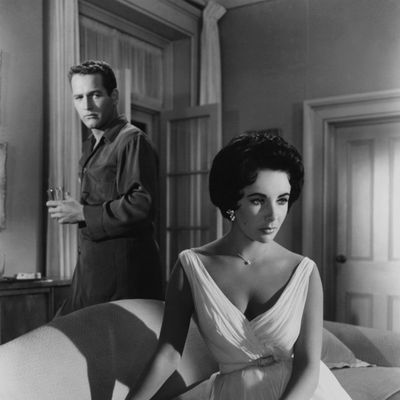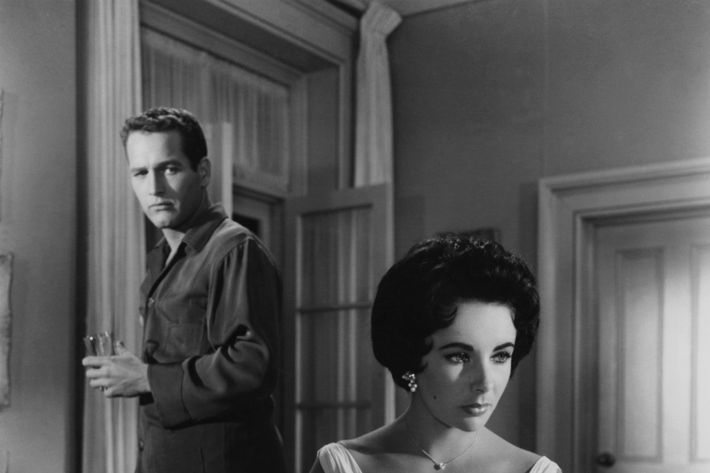

Elizabeth Taylor wasn’t a meaningful presence on film screens for 40 years, half her lifetime, and it’s likely that many who mourn her death at age 79 have never seen one of her movies, at least all the way through. Which is sad. So much of what we’ve come to associate with her — the classic forties and fifties Hollywood PR machinery at full throttle, the rise of the paparazzi in the sixties to document her theft of other women’s husbands, the merciless jokes about her weight gain and rehab and bad marriages (and bad re-marriages) — would never have mattered if there hadn’t, at the center, been her gift for being alive onscreen as few actresses before or since.
Was she a great actress? Maybe not. She had a high, wispy voice, which was lovely but without a lot of range. (She had little in the way of chest tones, surprisingly.) She was less poetic in motion than repose. She could get by onstage but no one mistook her for being at home there, as she was in front of the camera.
What Taylor had was something oddly rare in the annals of movie stars: certainty. However frail or neurasthenic or ravaged she appeared, she needed no one else to tell her she was a star. And with that confidence came honesty. She had no airs.
When you see her in her breakthrough role, in National Velvet, a 13-year-old shrimp coming shoulder high to Mickey Rooney, you can’t get over the grown-up steadiness in her eyes — which draws your own eyes away from everyone else and that gorgeous horse, too. Taylor’s certainty that she could play Velvet — which won over the film’s dubious producer — is at one with Velvet’s certainty that she can ride in the National. You already see what Camille Paglia called Taylor’s “liquid realm of emotion,” and it gives Velvet’s ambition a startling purity.
Elizabeth Taylor gave the lie to the conceit that movie-star glamour is a trick of the light (and the clothes designer and makeup person). It’s not that she’s “natural.” It’s that she’s not fake. She daydreamed as a child about being a movie star, she was groomed to be one at the great MGM compound, and she moved easily into the spotlight, knowing from an early age that people would want to look at her. Her lusciousness unhinges Montgomery Clift in A Place in the Sun, but she never seems like an embodiment of the dark side, the lure of the unnatural. It’s Shelley Winters’s Methody effusions (as the working-class girl) that look unnatural today.
Taylor came of age during the Method. She didn’t go in for it herself, but Method actors looked better opposite her than almost anyone else. She didn’t compete with them. She watched them do their thing and we watched her watch. She became a great duettist. She had wonderful chemistry with the delicate Clift — as well as other closeted actors.
Honest to a fault, she let no studio machinations interfere with her passions. Her acting career didn’t interfere with them either, alas. That meant that after the public-relations debacle of the endless Cleopatra shoot (and the endless movie that was the result), she stuck with her true love, Richard Burton, through some pretty dire pictures. The exception, of course, was Mike Nichols’s film of Edward Albee’s Who’s Afraid of Virginia Woolf?, which she pulled off better than anyone could have dreamed — almost too well. As Martha, Taylor’s girlishness became a mocking put-on with the aim of emasculating her husband. You could taste her pleasure in playing Albee’s blowsy, frowsy, slurry, sloppy ranter, in being everything onscreen that Elizabeth Taylor never had been. But in a strange way, Martha stuck to her more than any other role. The weight she gained for the part didn’t come off too easily. The drunken battles with Burton became more and more a part of her life — as did the drinking, although she could never match his two bottles a day. The pictures that followed were either terrible or, in the case of Reflections in a Golden Eye and X, Y, and Zee, terribly received.
Except for a couple of stage roles — in The Little Foxes and then a disastrous team-up with Burton in Private Lives — she accomplished nothing significant as an actress after the early seventies. In part it was that the good roles weren’t as common for American women after age 40. (Compare the career of Catherine Deneuve, a lesser actress, in Europe.) In part it was that her particular kind of voluptuousness didn’t sell as well in the post-Twiggy era. And Taylor wasn’t about to appear undignified, to seem to want the roles too much, the way Bette Davis and Joan Crawford did. She wouldn’t complain it was the pictures that got smaller.
So life, being Elizabeth Taylor, became her performance — and by all accounts she did it marvelously. She accomplished more for AIDS research in its grim early days than any other public figure. Almost everyone who met her adored her. The image of frailty she projected didn’t do justice to the strength she exhibited everyday.
The saddest thing is that Taylor the serious film actress ceased to exist almost four decades before she did — and she was good enough for us to mourn that loss still.


